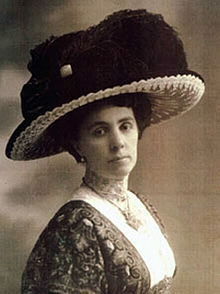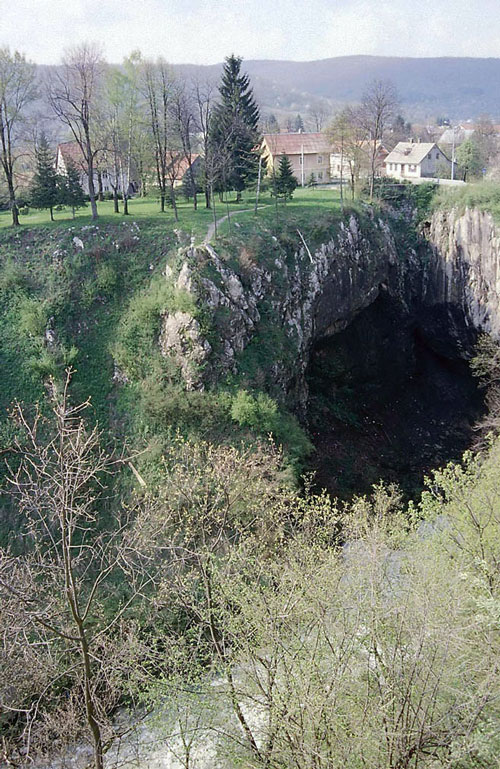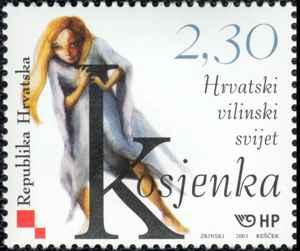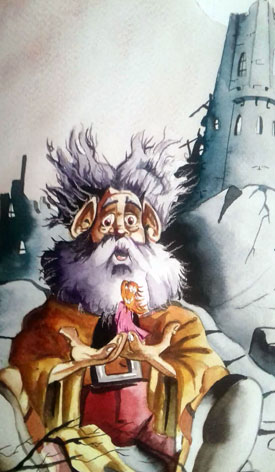Reygoch – the extremely strong and friendly giant

Just as Regoč (Reygoch) is my favourite giant amongst the famous giants, so is Legen Grad (the chilly Frosten City) where the writer Ivana Brlić Mažuranić situated the giant Reygoch in the same-named fairy tale, my favourite place: as in the mentioned fairy tale, so it is in reality – at the site above Đula’s Abyss in the very centre of the town of Ogulin.
Ivana Brlić Mažuranić was born in Ogulin on 18th April 1874, and shortly after her birth she moved away with family. The reason why Ivana is important for Ogulin and Ogulin for Ivana is the fact that as a small girl she made two return visits to her birthplace. She experienced these visits in a way that perhaps only a writer could, and so all the impressions and beauty of her birthplace are mentioned several times as well as several places, and also in her autobiography, and it is also well known that she wrote her fairy tales inspired by her native homeland. This is also the case with the fairy tale called ‘Reygoch’ in her collection ‘Croatian Tales of Long Ago’ published for the first time in 1916.
Although in the meantime since Ivana’s visits to this region, from the time she wrote the fairy tale, much has changed (so I believe), the place where Reygoch was located is still here to this day.
In the centre of the town of Ogulin, where the narrow river Dobra plunges under the ground at the end of a canyon having nowhere else to go, is the place which we call Đula’s Abyss. After 300 metres from where it drops, the abyss joins a cave system that so far has been measured at 16 km long under the town of Ogulin. There, where the canyon narrowed the Dobra to find a way under the ground, is a place of rocks, water, caverns, and a mark of the junction of two worlds – the visible and invisible, the end and beginning of something – Frosten City.
In Reygoch, a fairy tale of contrasts between the big and small, the lively and sluggish, the quick and slow, cold and warm, bright and stupid, light and dark, clouds and meadows, in a fairy tale that celebrates friendship, the meeting place of these extremes and the meeting place of the main characters, the giant Reygoch and the fairy Kosjenka (Curlylocks), is right here in Frosten City.

So, everything in the fairy tale began one lovely summer’s evening. The horsemen were watching their horses until they eventually fell asleep. And when they feel asleep, from the sky fairies began to arrive and steal away the horses to play with them a little, which was the fairy custom. That evening was special because from the clouds for the first there came a little fairy called Curlylocks, and she took hold of the liveliest black horse – young but fiery. Curlylocks loved to ride through the forest like a whirlwind on the pony. She wanted to ride even faster so she pinched the black horse on the ear, and as he was startled, he rose up on his hind legs, and shot off, leaving the other horses, the horsemen, the meadow and carried Curlylocks like a whirlwind far away.
They rode like the wind along fields, rivers, meadows, hills and valleys – Good gracious! How many things there are in the world – thought Curlylocks as she looked at all the beautiful things, however, what pleased her the most was one part she rushed past where there was a mountain, and on it there was a wonderful forest, and below the mountain two golden fields like two golden scarves, and on them were two white villages like two white doves, and a little further there was a large expanse of water – she liked that the most.
They dashed along for seven day and seven nights, on the seventh day before daybreak they arrived in the centre of a plain, and in the centre of this plain there stood the ruined walls of a frightfully large town called Frosten City, here a terrible coldness reigned. Here she threw her fairy veil over the wall and used it to climb over, and she remained in Frosten City alone. Curlylocks is a fairy who flies with the help of a veil and she looks after it very well because without it she cannot go back home in the clouds. But her black horse – he dashed around until his old age between the walls of Frosten City until he finally came to a door in the north – and immediately ran out once more onto the plain.
Curlylocks now walked through the town chilled to the bone and she thought that she must come across something wonderful in this town, but all she heard were the stones cracking from the cold.

All of a sudden, when she turned around the largest wall, there at the foot of the wall was a huge man asleep – bigger than the biggest oak in the biggest forest!
So big was this man that you could imagine that a church tower had fallen alongside the wall. His name was Reygoch and he lived in Frosten City and he nothing else to do but count the stones in the city. He would have never been able to count, if he hadn’t had such a huge head, like a barrel it was. However, he had been counting and counting – for a 1,000 years he counted like this and he had also counted the 30 walls and 5 gates of Frosten City.
When Curlylocks noticed Reygoch she crossed her arms in wonder – she could never have imagined that there was such a huge creature in the world.
And so the two began to talk. After they became acquainted, Curlylocks concluded that Reygoch was crazy! Really crazy, why does he live here and spend his life counting Frosten City’s abandoned rocks. And she invites him: “Let’s go, Reygoch, so that you see the wonders of the world and that you find yourself a more worthwhile job!”
At this he accepts because Curlylocks had been talking to him for so long, and he had never spoken to anyone anyway, plus he couldn’t resist her persuasion any longer. All that was left to see was how they would travel, she was a little fairy, and he was a huge giant.
When she came down to earth from the clouds, Curlylocks’ mother called her to her and said: “Curlylocks, here are some pearls for you. If you are in need, toss one pearl and you’ll get what you need. Take care of these pearls because there are so many things in the world that you’ll need them more and more.”
Curlylocks threw one pearl into the air and there appeared a little basket at Reygoch’s ear in which she could travel with him. Reygoch wanted to set off straight away, but Curlylocks stops him and asks: “Would we be able, Reygoch, to go under the ground, so I can see what is down there!?”
“Why wouldn’t we be able to!” answers Reygoch – and so their adventure begins.
They eventually came to the underground world and after a series of twists and turns, there was a great deluge when the water of the Zlovoda (the evil Banewater river) overflowed between two villages amongst which an angry feud ruled. A feud about a threshing floor and mills. However, the children from both villages didn’t care about the old people’s feud, and so they met every day and played whilst they looked after their sheep. There were a great-grandmother and great-grandfather who remembered everything that had ever happened in both villages. They would say: “Let the children be, people, their fun and games on the mountain will bear more fruit than your grain in the fields.”
On this journey and in this adventure, which almost costs them their life, Reygoch and Curlylocks helped the children and each other. They left the children alone, and they them, and the two oldest in the village – the great-grand mother and great-grand father too.
Curlylocks abandoned her fairy world in one moment when she gladly threw all her pearls with the children and gave her fairy veil so that the children were saved from the flood.

She gave up her fairy world and remained in the world of ordinary everyday life.
Reygoch, the good-natured and simple giant, in the end leaves the real human world and returns without a goodbye to the desolate world of Frosten City. When, that is, after the flood Reygoch saw the wise and oldest grandmother and grandfather he was scared like never before. He was frightened by their wrinkled, mottled, aged faces! He thought to himself: “How much horror had these old people experienced in this place to make their faces look like that?” – and he fled back to his desolate Frosten City.
As we retell the introduction to the tale of Reygoch above Đula’s Abyss in Ogulin we cannot escape the impression of how in this fairy tale the author faithfully described her native homeland.
The tale’s protagonists Curlylocks and Reygoch – two extremes – complement each other and continue in every interpretation of the abyss, which makes me proud and content as I interpret the abyss, the river Dobra, the underground world beneath Ogulin and the legend of Đula, and all of that with the sense and thought of how Reygoch is below us and how he is counting Frosten City’s abandoned rocks just as we are talking about it.

With interpretation the canyon of the Dobra, which is normally dry, desolate, rocky, cold and still, receives the dynamics and colourfulness of a fairy tale – site worthy of listening to. The river Dobra nevertheless, just as in the fairy tale, sometimes turns into the “evil” Banewater river overnight. If there is a lot of rain or when a lot of the snow melts, the canyon can fill with water in an instant, and then the surrounding countryside is in danger of flooding.
It would be wrong, besides Reygoch who, thanks to Ivana Brlić Mažuranić is placed in the abyss in the centre of the town, to not mention one more giant – Klek.
On the western slopes of the town the giant of the mountain of Klek has watched over both the town and its inhabitants with its proud, mystical, impressive form for centuries. Stories and legends also circle around him, and Ivana also took note of him. He inspired her to write in her autobiography in 1930: “The strange and striking forms of Klek and the romance of the river Dobra provided my imagination with so much food that I tossed and turned deep into the night with thoughts of the most curious images and fantastic possibilities: what was happening around Klek deep in the night?”
If you would like to hear and see more, you just have to come to Ogulin. You can reserve a date and time for a visit to the Fairy Tale Route in Ogulin with me, or the route and the fairy tales can come to you, to your school, nursery, institution or society.
The 1922 English edition of ‘Croatian Tales of Long Ago’ is available here: https://publicdomainreview.org/collections/croatian-tales-of-long-ago-1922/
Ivana Brlić Mažuranić – House of Fairy Tales visitor centre in Ogulin: http://www.ivaninakucabajke.hr/en/
Translated by Martin Mayhew